ignition INFINITI QX56 2007 Factory Service Manual
[x] Cancel search | Manufacturer: INFINITI, Model Year: 2007, Model line: QX56, Model: INFINITI QX56 2007Pages: 3061, PDF Size: 64.56 MB
Page 672 of 3061
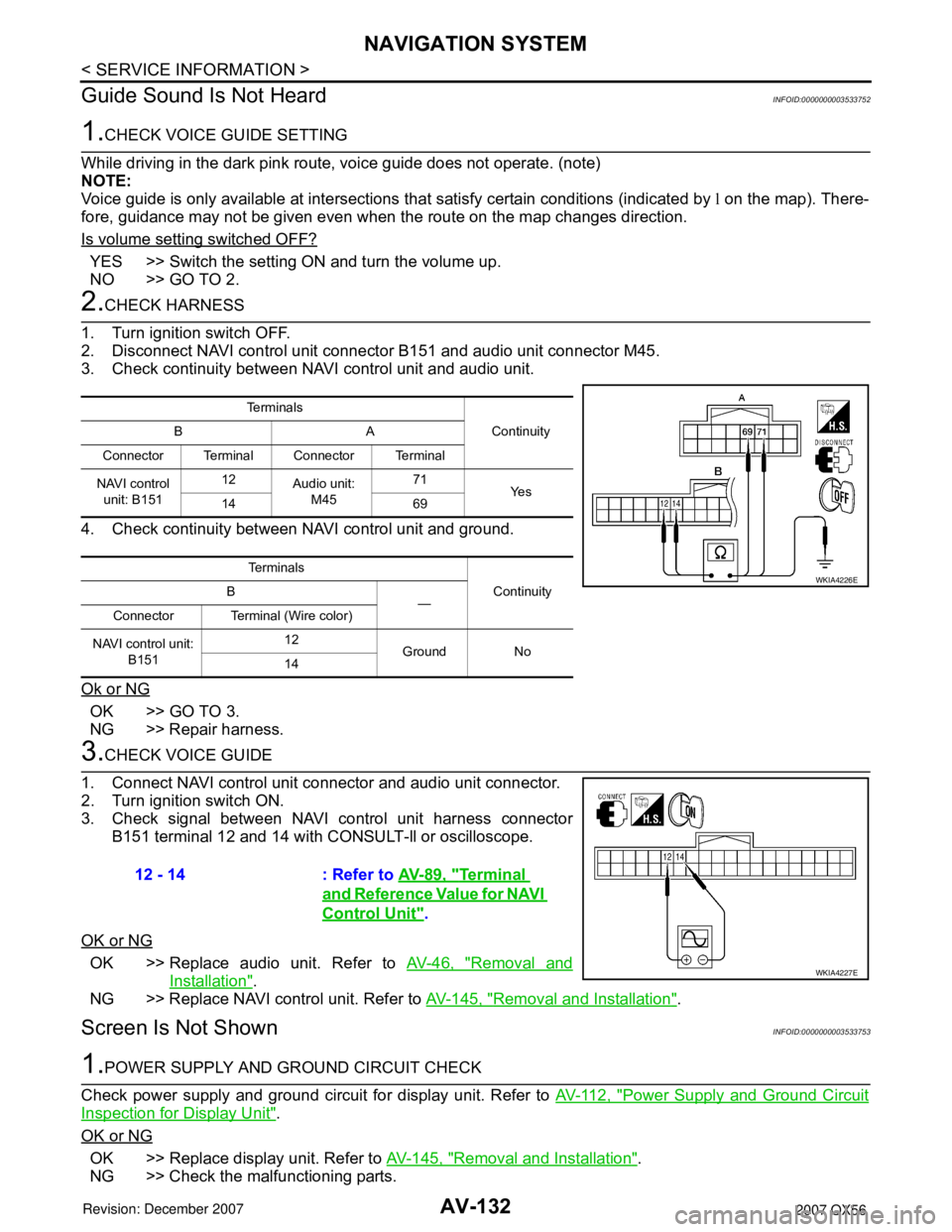
AV-132
< SERVICE INFORMATION >
NAVIGATION SYSTEM
Guide Sound Is Not Heard
INFOID:0000000003533752
1.CHECK VOICE GUIDE SETTING
While driving in the dark pink route, voice guide does not operate. (note)
NOTE:
Voice guide is only available at intersections that satisfy certain conditions (indicated by l on the map). There-
fore, guidance may not be given even when the route on the map changes direction.
Is volume setting switched OFF?
YES >> Switch the setting ON and turn the volume up.
NO >> GO TO 2.
2.CHECK HARNESS
1. Turn ignition switch OFF.
2. Disconnect NAVI control unit connector B151 and audio unit connector M45.
3. Check continuity between NAVI control unit and audio unit.
4. Check continuity between NAVI control unit and ground.
Ok or NG
OK >> GO TO 3.
NG >> Repair harness.
3.CHECK VOICE GUIDE
1. Connect NAVI control unit connector and audio unit connector.
2. Turn ignition switch ON.
3. Check signal between NAVI control unit harness connector
B151 terminal 12 and 14 with CONSULT-ll or oscilloscope.
OK or NG
OK >> Replace audio unit. Refer to AV-46, "Removal and
Installation".
NG >> Replace NAVI control unit. Refer to AV-145, "
Removal and Installation".
Screen Is Not ShownINFOID:0000000003533753
1.POWER SUPPLY AND GROUND CIRCUIT CHECK
Check power supply and ground circuit for display unit. Refer to AV-112, "
Power Supply and Ground Circuit
Inspection for Display Unit".
OK or NG
OK >> Replace display unit. Refer to AV-145, "Removal and Installation".
NG >> Check the malfunctioning parts.
Te r m i n a l s
Continuity BA
Connector Terminal Connector Terminal
NAVI control
unit: B15112
Audio unit:
M4571
Ye s
14 69
Te r m i n a l s
Continuity B
—
Connector Terminal (Wire color)
NAVI control unit:
B15112
Ground No
14
WKIA4226E
12 - 14 : Refer to AV-89, "Terminal
and Reference Value for NAVI
Control Unit".
WKIA4227E
Page 673 of 3061
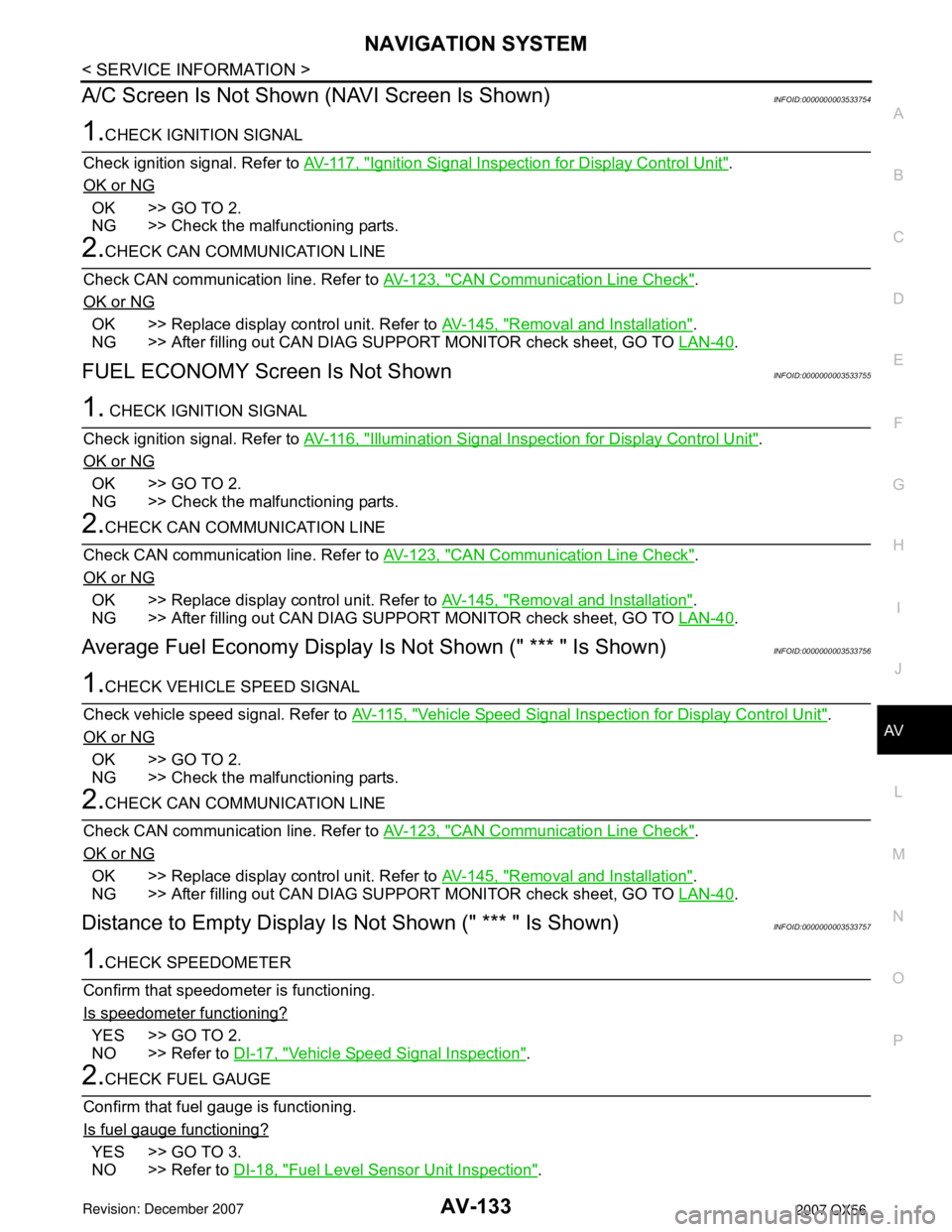
NAVIGATION SYSTEM
AV-133
< SERVICE INFORMATION >
C
D
E
F
G
H
I
J
L
MA
B
AV
N
O
P
A/C Screen Is Not Shown (NAVI Screen Is Shown)INFOID:0000000003533754
1.CHECK IGNITION SIGNAL
Check ignition signal. Refer to AV-117, "
Ignition Signal Inspection for Display Control Unit".
OK or NG
OK >> GO TO 2.
NG >> Check the malfunctioning parts.
2.CHECK CAN COMMUNICATION LINE
Check CAN communication line. Refer to AV-123, "
CAN Communication Line Check".
OK or NG
OK >> Replace display control unit. Refer to AV-145, "Removal and Installation".
NG >> After filling out CAN DIAG SUPPORT MONITOR check sheet, GO TO LAN-40
.
FUEL ECONOMY Screen Is Not ShownINFOID:0000000003533755
1. CHECK IGNITION SIGNAL
Check ignition signal. Refer to AV-116, "
Illumination Signal Inspection for Display Control Unit".
OK or NG
OK >> GO TO 2.
NG >> Check the malfunctioning parts.
2.CHECK CAN COMMUNICATION LINE
Check CAN communication line. Refer to AV-123, "
CAN Communication Line Check".
OK or NG
OK >> Replace display control unit. Refer to AV-145, "Removal and Installation".
NG >> After filling out CAN DIAG SUPPORT MONITOR check sheet, GO TO LAN-40
.
Average Fuel Economy Display Is Not Shown (" *** " Is Shown)INFOID:0000000003533756
1.CHECK VEHICLE SPEED SIGNAL
Check vehicle speed signal. Refer to AV-115, "
Vehicle Speed Signal Inspection for Display Control Unit".
OK or NG
OK >> GO TO 2.
NG >> Check the malfunctioning parts.
2.CHECK CAN COMMUNICATION LINE
Check CAN communication line. Refer to AV-123, "
CAN Communication Line Check".
OK or NG
OK >> Replace display control unit. Refer to AV-145, "Removal and Installation".
NG >> After filling out CAN DIAG SUPPORT MONITOR check sheet, GO TO LAN-40
.
Distance to Empty Display Is Not Shown (" *** " Is Shown)INFOID:0000000003533757
1.CHECK SPEEDOMETER
Confirm that speedometer is functioning.
Is speedometer functioning?
YES >> GO TO 2.
NO >> Refer to DI-17, "
Vehicle Speed Signal Inspection".
2.CHECK FUEL GAUGE
Confirm that fuel gauge is functioning.
Is fuel gauge functioning?
YES >> GO TO 3.
NO >> Refer to DI-18, "
Fuel Level Sensor Unit Inspection".
Page 674 of 3061
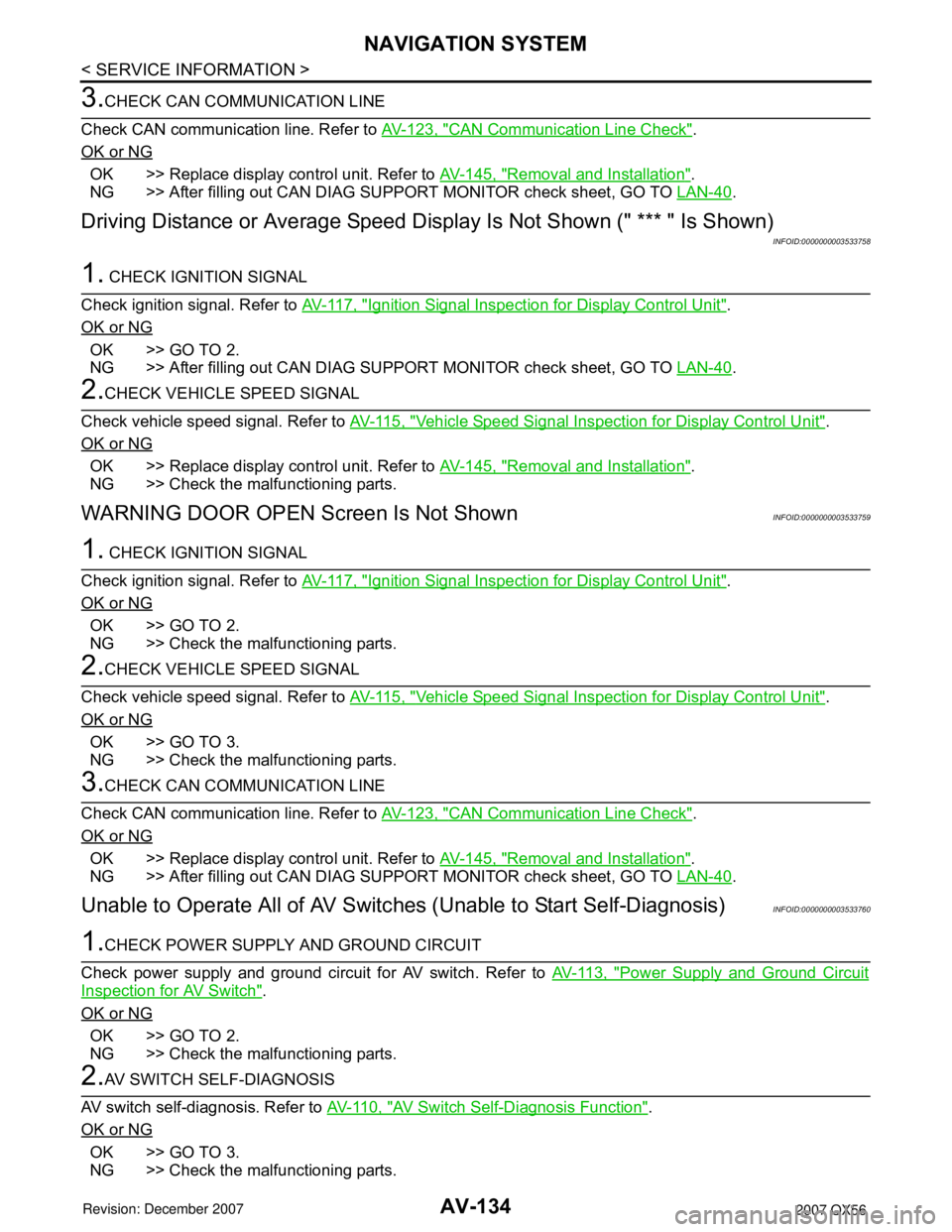
AV-134
< SERVICE INFORMATION >
NAVIGATION SYSTEM
3.CHECK CAN COMMUNICATION LINE
Check CAN communication line. Refer to AV-123, "
CAN Communication Line Check".
OK or NG
OK >> Replace display control unit. Refer to AV-145, "Removal and Installation".
NG >> After filling out CAN DIAG SUPPORT MONITOR check sheet, GO TO LAN-40
.
Driving Distance or Average Speed Display Is Not Shown (" *** " Is Shown)
INFOID:0000000003533758
1. CHECK IGNITION SIGNAL
Check ignition signal. Refer to AV-117, "
Ignition Signal Inspection for Display Control Unit".
OK or NG
OK >> GO TO 2.
NG >> After filling out CAN DIAG SUPPORT MONITOR check sheet, GO TO LAN-40
.
2.CHECK VEHICLE SPEED SIGNAL
Check vehicle speed signal. Refer to AV-115, "
Vehicle Speed Signal Inspection for Display Control Unit".
OK or NG
OK >> Replace display control unit. Refer to AV-145, "Removal and Installation".
NG >> Check the malfunctioning parts.
WARNING DOOR OPEN Screen Is Not ShownINFOID:0000000003533759
1. CHECK IGNITION SIGNAL
Check ignition signal. Refer to AV-117, "
Ignition Signal Inspection for Display Control Unit".
OK or NG
OK >> GO TO 2.
NG >> Check the malfunctioning parts.
2.CHECK VEHICLE SPEED SIGNAL
Check vehicle speed signal. Refer to AV-115, "
Vehicle Speed Signal Inspection for Display Control Unit".
OK or NG
OK >> GO TO 3.
NG >> Check the malfunctioning parts.
3.CHECK CAN COMMUNICATION LINE
Check CAN communication line. Refer to AV-123, "
CAN Communication Line Check".
OK or NG
OK >> Replace display control unit. Refer to AV-145, "Removal and Installation".
NG >> After filling out CAN DIAG SUPPORT MONITOR check sheet, GO TO LAN-40
.
Unable to Operate All of AV Switches (Unable to Start Self-Diagnosis)INFOID:0000000003533760
1.CHECK POWER SUPPLY AND GROUND CIRCUIT
Check power supply and ground circuit for AV switch. Refer to AV-113, "
Power Supply and Ground Circuit
Inspection for AV Switch".
OK or NG
OK >> GO TO 2.
NG >> Check the malfunctioning parts.
2.AV SWITCH SELF-DIAGNOSIS
AV switch self-diagnosis. Refer to AV-110, "
AV Switch Self-Diagnosis Function".
OK or NG
OK >> GO TO 3.
NG >> Check the malfunctioning parts.
Page 676 of 3061
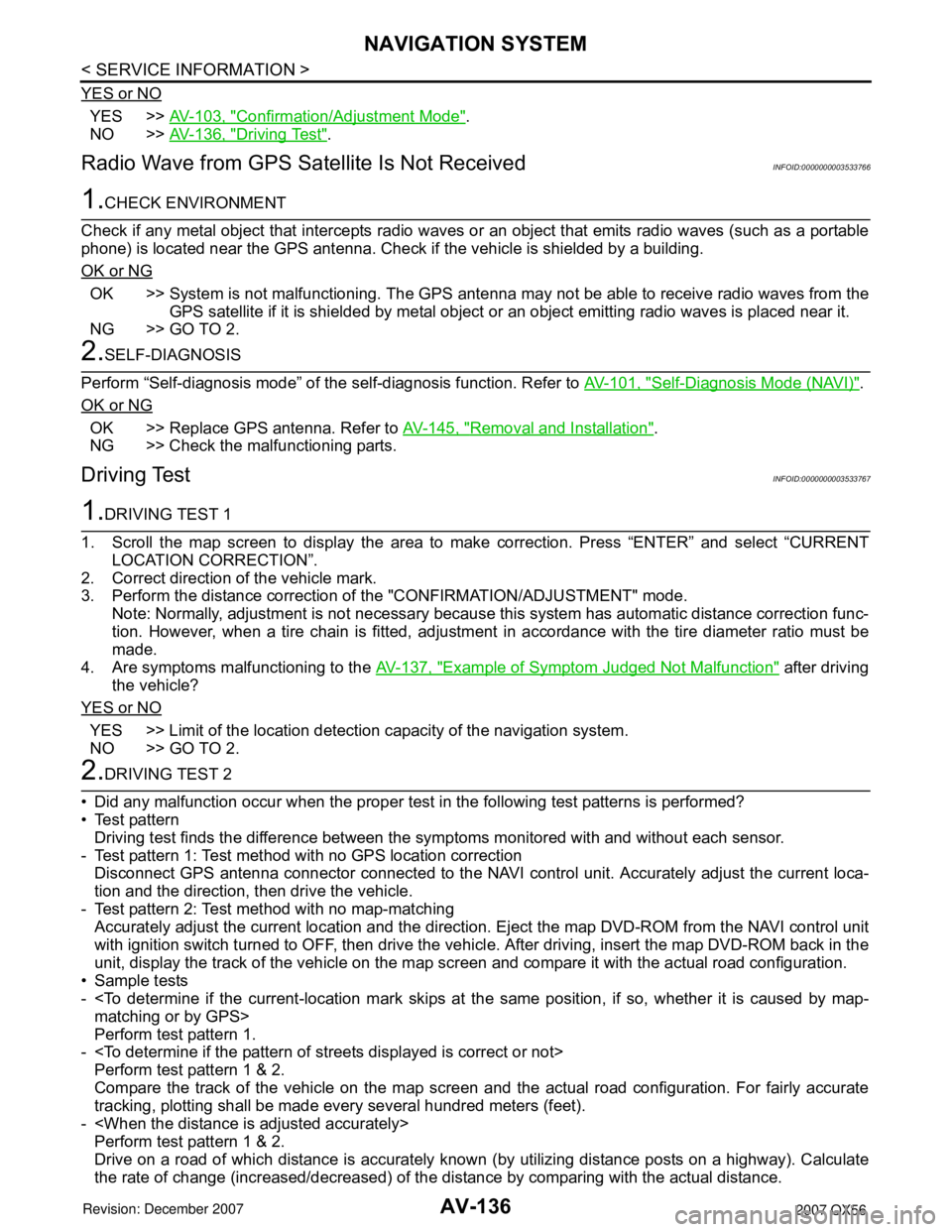
AV-136
< SERVICE INFORMATION >
NAVIGATION SYSTEM
YES or NO
YES >>AV-103, "Confirmation/Adjustment Mode".
NO >>AV-136, "
Driving Test".
Radio Wave from GPS Satellite Is Not ReceivedINFOID:0000000003533766
1.CHECK ENVIRONMENT
Check if any metal object that intercepts radio waves or an object that emits radio waves (such as a portable
phone) is located near the GPS antenna. Check if the vehicle is shielded by a building.
OK or NG
OK >> System is not malfunctioning. The GPS antenna may not be able to receive radio waves from the
GPS satellite if it is shielded by metal object or an object emitting radio waves is placed near it.
NG >> GO TO 2.
2.SELF-DIAGNOSIS
Perform “Self-diagnosis mode” of the self-diagnosis function. Refer to AV-101, "
Self-Diagnosis Mode (NAVI)".
OK or NG
OK >> Replace GPS antenna. Refer to AV-145, "Removal and Installation".
NG >> Check the malfunctioning parts.
Driving TestINFOID:0000000003533767
1.DRIVING TEST 1
1. Scroll the map screen to display the area to make correction. Press “ENTER” and select “CURRENT
LOCATION CORRECTION”.
2. Correct direction of the vehicle mark.
3. Perform the distance correction of the "CONFIRMATION/ADJUSTMENT" mode.
Note: Normally, adjustment is not necessary because this system has automatic distance correction func-
tion. However, when a tire chain is fitted, adjustment in accordance with the tire diameter ratio must be
made.
4. Are symptoms malfunctioning to the AV-137, "
Example of Symptom Judged Not Malfunction" after driving
the vehicle?
YES or NO
YES >> Limit of the location detection capacity of the navigation system.
NO >> GO TO 2.
2.DRIVING TEST 2
• Did any malfunction occur when the proper test in the following test patterns is performed?
• Test pattern
Driving test finds the difference between the symptoms monitored with and without each sensor.
- Test pattern 1: Test method with no GPS location correction
Disconnect GPS antenna connector connected to the NAVI control unit. Accurately adjust the current loca-
tion and the direction, then drive the vehicle.
- Test pattern 2: Test method with no map-matching
Accurately adjust the current location and the direction. Eject the map DVD-ROM from the NAVI control unit
with ignition switch turned to OFF, then drive the vehicle. After driving, insert the map DVD-ROM back in the
unit, display the track of the vehicle on the map screen and compare it with the actual road configuration.
• Sample tests
-
Perform test pattern 1.
-
Perform test pattern 1 & 2.
Compare the track of the vehicle on the map screen and the actual road configuration. For fairly accurate
tracking, plotting shall be made every several hundred meters (feet).
-
Perform test pattern 1 & 2.
Drive on a road of which distance is accurately known (by utilizing distance posts on a highway). Calculate
the rate of change (increased/decreased) of the distance by comparing with the actual distance.
Page 677 of 3061

NAVIGATION SYSTEM
AV-137
< SERVICE INFORMATION >
C
D
E
F
G
H
I
J
L
MA
B
AV
N
O
P
Correction = A/B
A: Distance shown on the screen
B: Actual distance
YES or NO
YES >> • If adjustment is insufficient, perform adjustment again.
• If any error is found in the map, please contact map data supplier. Refer to Navigation System
Owner's Manual for contact information.
• Replace NAVI control unit. Refer to AV-145, "
Removal and Installation".
NO >> Limit of the location detection capacity of the navigation system.
Example of Symptom Judged Not MalfunctionINFOID:0000000003533768
BASIC OPERATION
VEHICLE MARK
Symptom Cause Remedy
No image is shown. Display brightness adjustment is set fully to DARK
side.Adjust the display brightness.
No guide sound is heard.
Audio guide volume is too low or
too high.Volume control is set to OFF, MIN or MAX. Adjust the audio guide volume.
Audio guidance is not available while the vehicle is
driving on a dark pink route.System is not malfunctioning.
Screen is too dark.
Motion of the image is too slow.Temperature inside the vehicle is low. Wait until the temperature inside the vehicle
reaches the proper temperature.
Small black or bright spots appear
on the screen.Symptom peculiar to a liquid crystal display (dis-
play unit).System is not malfunction.
Symptom Cause Remedy
Map screen and BIRDVIEW™
Name of the place varies with the
screen.Some thinning of the character data is done to pre-
vent the display becoming to complex. In some
cases and in some locations, the display contents
may differ.
The same place name, street name, etc. may not
be displayed every time on account of the data
processing.System is not malfunctioning.
Vehicle mark is not positioned cor-
rectly.Vehicle is transferred by ferry or by towing after its
ignition switch is turned to OFF.Drive the vehicle for a while in the GPS sat-
ellite signal receiving condition.
Screen will not switch to nighttime
mode after the lighting switch is
turned ON.The daytime screen is selected by the “SWITCH
SCREENS” when the last time the screen dim-
ming setting is done.
Switching between daytime/nighttime screen may
be inhibited by the automatic illumination adjust-
ment function.Perform screen dimming and select the
nighttime screen by “SWITCH SCREENS”.
Map screen will not scroll in accor-
dance with the vehicle travel.Current location is not displayed. Press “MAP” button to display the current lo-
cation.
Vehicle mark will not be shown. Current location is not displayed. Press “MAP” button to display the current lo-
cation.
Accuracy indicator (GPS satellite
mark) on the map screen stays
gray.GPS satellite signal is intercepted because the ve-
hicle is in or behind a building.Move the vehicle out to an open space.
GPS satellite signal cannot be received because
an obstacle is placed on top of the instrument pan-
el.Do not place anything in the center on top of
the display.
GPS satellites are not visible from current location. Wait until GPS satellites are visible by mov-
ing the vehicle.
Page 682 of 3061

AV-142
< SERVICE INFORMATION >
NAVIGATION SYSTEM
PlaceIn a parking lot When driving in a parking lot, or other loca-
tion where there are no roads on the map,
matching may place the vehicle mark on a
nearby road. When the vehicle returns to
the road, the vehicle mark may have devi-
ated from the correct location.
When driving in circle or turning the steer-
ing wheel repeatedly, direction errors accu-
mulate, and the vehicle mark may deviate
from the correct location.
If after travelling about 10 km (6
miles) the correct location has
not been restored, perform lo-
cation correction and, if neces-
sary, direction correction. Turntable
When the ignition switch is OFF, the navi-
gation system cannot get the signal from
the gyroscope (angular speed sensor).
Therefore, the displayed direction may be
wrong and the correct road may not be eas-
ily returned to after rotating the vehicle on a
turntable with the ignition OFF.
Slippery roads On snow, wet roads, gravel, or other roads
where tires may slip easily, accumulated
mileage errors may cause the vehicle mark
to deviate from the correct road.
Slopes When parking in sloped garages, when
travelling on banked roads, or in other cas-
es where the vehicle turns when tilted, an
error in the turning angle will occur, and the
vehicle mark may deviate from the road.
Map dataRoad not displayed on the map screen
When driving on new roads or other roads
not displayed on the map screen, map
matching does not function correctly and
matches the location to a nearby road.
When the vehicle returns to a road which is
on the map, the vehicle mark may deviate
from the correct road.
Different road pattern
(Changed due to repair)
If the road pattern stored in the map data
and the actual road pattern are different,
map matching does not function correctly
and matches the location to a nearby road.
The vehicle mark may deviate from the cor-
rect road.
Vehicle Use of tire chainsWhen tire chains are used, the mileage is
not correctly detected, and the vehicle mark
may deviate from the correct road.Drive the vehicle for a while. If
the distance still deviates, ad-
just it by using the distance ad-
justment function. (If the tire
chain is removed, recover the
original value.) Cause (condition) –: While driving ooo: Display Driving condition Remarks (correction, etc.)
SEL709V
SEL710V
SEL699V
ELK0201D
Page 683 of 3061

NAVIGATION SYSTEM
AV-143
< SERVICE INFORMATION >
C
D
E
F
G
H
I
J
L
MA
B
AV
N
O
P
CURRENT-LOCATION MARK SHOWS A POSITION WHICH IS COMPLETELY WRONG
In the following cases, the current-location mark may appear on completely different position in the map
depending on the GPS satellite signal receiving conditions. In this case, perform location correction and direc-
tion correction.
• When location correction has not been done
- If the receiving conditions of the GPS satellite signal is poor, or if the current-location mark becomes out of
place, it may move to a completely different location and not come back if location correction is not done.
The position will be corrected if the GPS signal can be received.
• When the vehicle has traveled by ferry, or when the vehicle has been towed
- Because calculation of the current location cannot be done when travelling with the ignition OFF, for exam-
ple when traveling by ferry or when being towed, the location before travel is displayed. If the precise loca-
tion can be detected with GPS, the location will be corrected.
CURRENT-LOCATION MARK JUMPS
In the following cases, the current-location mark may appear to jump as a result of automatic correction of the
current location.
• When map-matching has been done
- If the current location and the current-location mark are different when map-matching is done, the current-
location mark may seem to jump. At this time, the location may be “corrected” to the wrong road or to a loca-
tion which is not on a road.
• When GPS location correction has been done
- If the current location and the current-location mark are different when the location is corrected using GPS
measurements, the current-location mark may seem to jump. At this time, the location may be “corrected” to
a location which is not on a road.
CURRENT-LOCATION MARK IS IN A RIVER OR SEA
The navigation system moves the current-location mark with no distinction between land and rivers or sea. If
the location mark is somehow out of place, it may appear that the vehicle is driving in a river or the sea.
WHEN DRIVING ON SAME ROAD, SOMETIMES CURRENT-LOCATION MARK IS IN RIGHT
Precautions
for drivingJust after the engine is startedIf the vehicle is driven just after the engine
is started when the gyroscope (angular
speed sensor) correction is not completed,
the vehicle can lose its direction and may
have deviated from the correct location.Wait for a short while before
driving after starting the engine.
Continuous driving without stopping When driving long distances without stop-
ping, direction errors may accumulate, and
the current-location mark may deviate from
the correct road.Stop and adjust the orientation.
Abusive driving Spinning the wheels or engaging in other
kinds of abusive driving may result in the
system being unable perform correct detec-
tion, and may cause the vehicle mark to de-
viate from the correct road.If after travelling about 10 km (6
miles) the correct location has
not been restored, perform lo-
cation correction and, if neces-
sary, direction correction.
How to cor-
rect locationPosition correction accuracy
If the accuracy of location settings is poor,
accuracy may be reduced when the correct
road cannot be found, particularly in places
where there are many roads.Enter in the road displayed on
the screen with an accuracy of
approx. 1mm.
Caution: Whenever possible,
use detailed map for the correc-
tion.
Direction when location is corrected
If the accuracy of location settings during
correction is poor, accuracy may be re-
duced afterwards.Perform direction correction. Cause (condition) –: While driving ooo: Display Driving condition Remarks (correction, etc.)
SEL701V
SEL702V
Page 692 of 3061

BCM (BODY CONTROL MODULE)
BCS-5
< SERVICE INFORMATION >
C
D
E
F
G
H
I
J
L
MA
B
BCS
N
O
P
Normal status
• When BCM is not in sleep status, OUTPUT terminals (1-5) each turn ON-OFF every 10ms.
Sleep status
• When BCM is in sleep mode, transistors of OUTPUT 1 and 5 stop the output, and BCM enters low-cur-
rent-consumption mode. OUTPUTS (2, 3, and 4) turn ON-OFF at 60ms intervals, and receives lighting
switch input only.
CAN COMMUNICATION CONTROL
CAN communication allows a high rate of information through the two communication lines (CAN-L, CAN-H)
connecting the various control units in the system. Each control unit transmits/receives data, but selectively
reads required data only.
BCM STATUS CONTROL
BCM changes its status depending on the operation status in order to reduce power consumption.
1. CAN communication status
• With ignition switch ON, CAN communicates with other control units normally.
• Control by BCM is being operated properly.
• When ignition switch is OFF, switching to sleep mode is possible.
• Even when ignition switch is OFF, if CAN communication with IPDM E/R and combination meter is
active, CAN communication status is active.
2. Sleep transient status
• This status shuts down CAN communication when ignition switch is turned OFF.
• It transmits sleep request signal to IPDM E/R and combination meter.
• Two seconds after CAN communication of all control units stops, CAN communication switches to inac-
tive status.
3. CAN communication inactive status
• With ignition switch OFF, CAN communication is not active.
• With ignition switch OFF, control performed only by BCM is active.
• Three seconds after CAN communication of all control units stops, CAN communication switches to
inactive status.
4. Sleep status
• BCM is activated with low current consumption mode.
• CAN communication is not active.
WKIA4093E
Page 693 of 3061
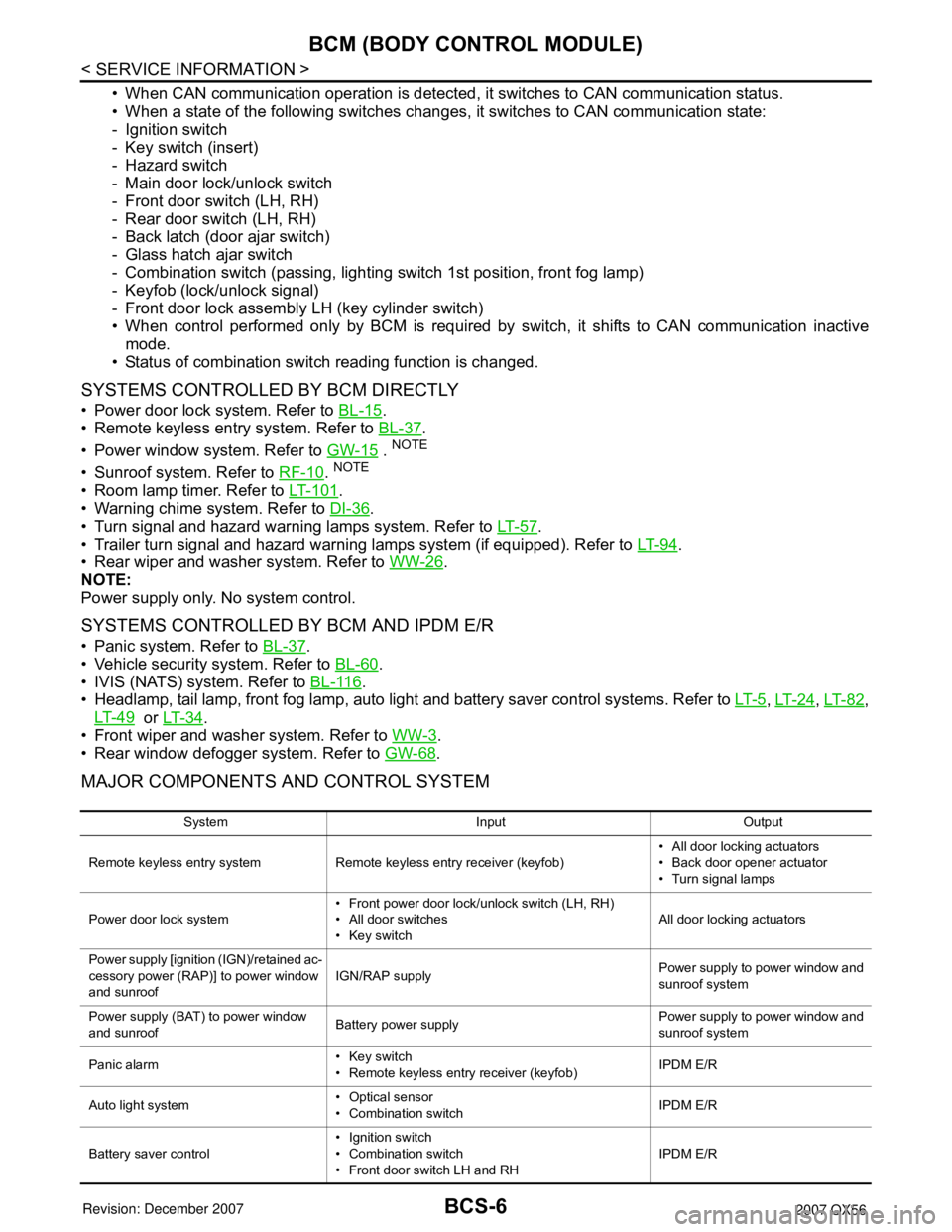
BCS-6
< SERVICE INFORMATION >
BCM (BODY CONTROL MODULE)
• When CAN communication operation is detected, it switches to CAN communication status.
• When a state of the following switches changes, it switches to CAN communication state:
- Ignition switch
- Key switch (insert)
- Hazard switch
- Main door lock/unlock switch
- Front door switch (LH, RH)
- Rear door switch (LH, RH)
- Back latch (door ajar switch)
- Glass hatch ajar switch
- Combination switch (passing, lighting switch 1st position, front fog lamp)
- Keyfob (lock/unlock signal)
- Front door lock assembly LH (key cylinder switch)
• When control performed only by BCM is required by switch, it shifts to CAN communication inactive
mode.
• Status of combination switch reading function is changed.
SYSTEMS CONTROLLED BY BCM DIRECTLY
• Power door lock system. Refer to BL-15.
• Remote keyless entry system. Refer to BL-37
.
• Power window system. Refer to GW-15
. NOTE
• Sunroof system. Refer to RF-10. NOTE
• Room lamp timer. Refer to LT-101.
• Warning chime system. Refer to DI-36
.
• Turn signal and hazard warning lamps system. Refer to LT- 5 7
.
• Trailer turn signal and hazard warning lamps system (if equipped). Refer to LT- 9 4
.
• Rear wiper and washer system. Refer to WW-26
.
NOTE:
Power supply only. No system control.
SYSTEMS CONTROLLED BY BCM AND IPDM E/R
• Panic system. Refer to BL-37.
• Vehicle security system. Refer to BL-60
.
• IVIS (NATS) system. Refer to BL-116
.
• Headlamp, tail lamp, front fog lamp, auto light and battery saver control systems. Refer to LT- 5
, LT- 2 4, LT- 8 2,
LT- 4 9
or LT- 3 4.
• Front wiper and washer system. Refer to WW-3
.
• Rear window defogger system. Refer to GW-68
.
MAJOR COMPONENTS AND CONTROL SYSTEM
System Input Output
Remote keyless entry system Remote keyless entry receiver (keyfob)• All door locking actuators
• Back door opener actuator
• Turn signal lamps
Power door lock system• Front power door lock/unlock switch (LH, RH)
• All door switches
• Key switchAll door locking actuators
Power supply [ignition (IGN)/retained ac-
cessory power (RAP)] to power window
and sunroofIGN/RAP supplyPower supply to power window and
sunroof system
Power supply (BAT) to power window
and sunroofBattery power supplyPower supply to power window and
sunroof system
Panic alarm• Key switch
• Remote keyless entry receiver (keyfob)IPDM E/R
Auto light system• Optical sensor
• Combination switchIPDM E/R
Battery saver control• Ignition switch
• Combination switch
• Front door switch LH and RHIPDM E/R
Page 698 of 3061

BCM (BODY CONTROL MODULE)
BCS-11
< SERVICE INFORMATION >
C
D
E
F
G
H
I
J
L
MA
B
BCS
N
O
P
Terminal and Reference Value for BCMINFOID:0000000003533600
Te r m i n a lWire
colorSignal nameSignal
input/
outputMeasuring condition
Reference value or waveform
(Approx.) Ignition
switchOperation or condition
1BR/WIgnition keyhole illumi-
nationOutput OFFDoor is locked (SW OFF) Battery voltage
Door is unlocked (SW ON) 0V
2SBCombination switch
input 5Input ONLighting, turn, wiper OFF
Wiper dial position 4
3G/YCombination switch
input 4Input ONLighting, turn, wiper OFF
Wiper dial position 4
4YCombination switch
input 3Input ONLighting, turn, wiper OFF
Wiper dial position 4
5G/BCombination switch
input 2
Input ONLighting, turn, wiper OFF
Wiper dial position 4
6VCombination switch
input 1
9Y/BRear window defogger
switchInput ONRear window defogger switch
ON0V
Rear window defogger switch
OFF5V
10 G Hazard lamp flash Input OFFON (opening or closing) 0V
OFF (other than above) Battery voltage
11 OIgnition switch (ACC
or ON)InputACC or
ONIgnition switch ACC or ON Battery voltage
12 R/L Front door switch RH Input OFFON (open) 0V
OFF (closed) Battery voltage
13 GR Rear door switch RH Input OFFON (open) 0V
OFF (closed) Battery voltage
15 L/WTire pressure warning
check connectorInput OFF — 5V
SKIA5291E
SKIA5292E
SKIA5291E
SKIA5292E